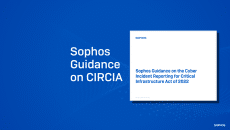
Note: this information is relevant to US based organizations; click the image above to download the report.
In March 2022, President Biden signed the Cyber Incident Reporting for Critical Infrastructure Act of 2022 (CIRCIA) into law in the United States. Its enactment requires the U.S. Cybersecurity and Infrastructure Security Agency (CISA) to develop and implement regulations requiring covered entities to report covered cyber incidents and ransomware payments to CISA, within 24 months of passing the law. The new law grants CISA with its first-ever enforcement powers.
CISA is expected to deliver a Notice of Proposed Rulemaking (NPRM) in early 2024 that will highlight the proposed reporting requirements, which are expected to be available for feedback before final publication in 2025. For updated guidance and feedback opportunities, organizations can visit https://www.cisa.gov/CIRCIA.
The legislation implements regulations on United States “Covered Entities” in the critical infrastructure sector, as defined by Presidential Policy Directive 211. Covered entities are organizations within industry sectors considered to be “critical infrastructure,” listed in the table below. The sectors and their Sector Specific Agencies (SSAs) include, but are not limited to:
It is worth noting that Education is considered a subsector of the Government Facilities Sector,2 and the Education Facilities Subsector encompasses prekindergarten through 12th grade, as well as post-secondary public, private, and proprietary education facilities.
Reporting is not required until CISA’s Final Rule implementing CIRCIA’s reporting requirements goes into effect, which is expected in 2025. Until then, organizations are strongly encouraged to voluntarily share cyber incident information with CISA, and they can be reached 24/7 at report@cisa.gov, or (888) 282-08703, or their online portal at https://www.cisa.gov/report. More information regarding the final legislation and voluntary reporting can be found here4.
However, once the Final Rule goes into effect, it will likely require “Covered Entities” to:
Report a covered cyber incident within 72 hours
Report a ransomware payment within 24 hours of making the transaction
Submit updates on a previously submitted report if new information becomes available, or a ransomware payment was made after submitting a report
Preserve data relevant to the incident or ransom payment according to procedures to be outlined in the final legislation
If a “Covered Entity” is a victim of a cyber incident and makes a ransomware payment prior to the 72-hour reporting requirement, they may likely be allowed to submit one single report, however, final reporting procedures are still to be determined.
The final definition is yet to be proposed; however it will likely include at a minimum:
Substantial loss of confidentiality, integrity, or availability of such information system or network, or a serious impact on the safety and resiliency of operational systems and processes
Disruption of business or industrial operations, including due to a denial-of-service attack, ransomware attack, or exploitation of a zero-day vulnerability, against:
an information system or network
an operational technology system or process
Unauthorized access or disruption of business or industrial operations due to loss of service facilitated through, or caused by, a compromise of a cloud service provider, managed service provider, or other third-party data hosting provider or by a supply chain compromise
The final legislation will also likely account for the sophistication or novelty of tactics used to perpetrate a cyber incident, as well as:
The type, volume, and sensitivity of the data at issue
The number of individuals directly or indirectly affected or potentially affected by such a cyber incident
Potential impacts on industrial control systems, such as supervisory control and data acquisition systems, distributed control systems, and programmable logic controllers
The final required reporting content may vary, and will be available after publication, but as a best practice in incident response management, Covered Entities should be prepared to report:
Incident date and time
Incident location
Type of observed activity
Detailed narrative of the event
Number of people or systems affected
Company/Organization name
Point of Contact details
Severity of event
Critical Infrastructure Sector if known
Anyone else that was informed
Other information that may be required could include:
The impact to the operations of the covered entity
A description of exploited vulnerabilities where applicable and actor TTPs (tactics, techniques, and procedures) used to perpetrate the cyber incident
Categories of information believed to have been accessed
Any identifying information or contact information related to the attacker if available, ie in the case of a ransomware event
Contact information for an entity that may have made a ransom payment on behalf of the affected organization
The ransom instructions, demand, and type of currency used
Entities deemed critical infrastructure that are required to report a cyber incident or ransom payment may be allowed to use a third party to submit the report on their behalf. The final guidance on how to use a third party will be available with the final regulations, but it is expected that the list of third parties will likely include:
Incident response companies
Insurance providers
Service providers
Information Sharing and Analysis Organizations (ISAOs)
Law firms
If an impacted organization misses the 72-hour deadline, a subpoena may be issued by the Director of CISA to compel disclosure of information deemed necessary. The final regulations will fully define enforcement methods and what can be expected.
CIRCIA reports are expected to be considered the commercial, financial, and proprietary information of the covered entity and are likely exempt from disclosure under section 552(b)(3) of title 5, United States Code (commonly known as the ‘Freedom of Information Act’), as well as any provision of State, Tribal, or local freedom of information law, open government law, open meetings law, open records law, sunshine law, or similar law requiring disclosure of information or records. Such an exemption is likely to require the reporting entity to assert its rights in writing under this section.
2 https://www.dhs.gov/xlibrary/assets/nppd/nppd-ip-education-facilities-snapshot-2011.pdf
4909 Murphy Canyon Road Suite, 500
San Diego, CA 92123
Store
Company
Support
Newsletter
Technology Solutions You Can Trust Dismiss